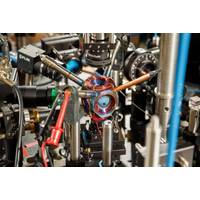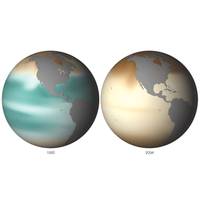
Why There May Be Oceans Inside Dwarf Planets Beyond Pluto
looking at the ratios of various isotopes (atoms that have more or fewer particles called neutrons in their nucleus) in the frozen methane that coats Eris and Makemake, two dwarf planets a little smaller and considerably more remote than Pluto.The authors claim their observations are evidence of chemical reactions between internal ocean water and the ocean floor rock, and also of fairly young, possibly even present day, plumes of water. The authors suggest that heat from the decay of radioactive elements in the rock is sufficient to explain how these internal oceans have been kept warm enough to avoid

Shed the Satellite: Quantum Sensors hold Promise for Future GPS-Free Navigation
her team has shown that quantum sensing can work without a high-powered vacuum system. This shrinks the package to a practical size without sacrificing reliability.Instead of a powered vacuum pump, which whisks away molecules that leak in and wreck measurements, a pair of devices called getters use chemical reactions to bind intruders. The getters are each about the size of a pencil eraser so they can be tucked inside two narrow tubes sticking out of the titanium package. They also work without a power source.To further keep out contaminants, Schwindt partnered with Sandia materials scientists to build

Metal Pollution is Leaving Scallops Helpless Against Crabs and Lobsters
than shells found at other areas, and that the internal structure of shells contained a disruption, or fault line. We were not able to detect metals in the shells themselves, but we think that even in low quantities the metals are either affecting the physiology of the scallops or disrupting chemical reactions during the mineralization (shell-growing) process.In ecotoxicology terms, what we observed is called a non-apical endpoint effect. Weakened shells don’t directly kill scallops, but instead leave them more vulnerable to mortality. Such responses are rarely considered when assessing the

The Quest for the Moho
the crust-mantle boundary—or at least not at slow-spreading ridges. It could be an alteration front as Hess said”—the limit of where seawater percolates down, reacts with peridotite in the mantle, and changes it into a less dense rock called hydrated serpentinite. Those chemical reactions have a lot of implications. First, they cause carbon dissolved in seawater to precipitate as calcium carbonate rock, or limestone. “All those buildings on Wall Street that have green marble with white streaks through it are made of hydrated serpentinites,” Dick said. &ldquo

The Lowdown on Ocean Acidification
don’t live in the ocean and we don’t drink seawater. We care because there is only one Earth and one biosphere. Oceans cover about 70 percent of the Earth’s surface and constitute more than 90 percent of the biosphere (that portion of the Earth capable of supporting life). Many chemical reactions, including those essential to life, are sensitive to even small changes in the pH level. A small change in the pH of seawater can have harmful effects on marine life, impacting chemical communication, reproduction and growth. Ocean carbonate chemistry is a natural buffering system, but this
Chinese Submarine Dives into Indian Ocean
see active hydrothermal vent and polymetallic sulfide in seabed and examine the environment in selected sites, the mission's top scientist, Tao Chunhui, said. The data will play a significant role in China's future research on polymetallic sulfide, Tao added. Different metals become sulfides after chemical reactions and come to rest in the seabed in "chimney vents". The Chinese submersible vessel is called Jiaolong, a name inspired from a mythical dragon. China has also tested a remote-controlled underwater vehicle, Longzhu.


 February 2024
February 2024





